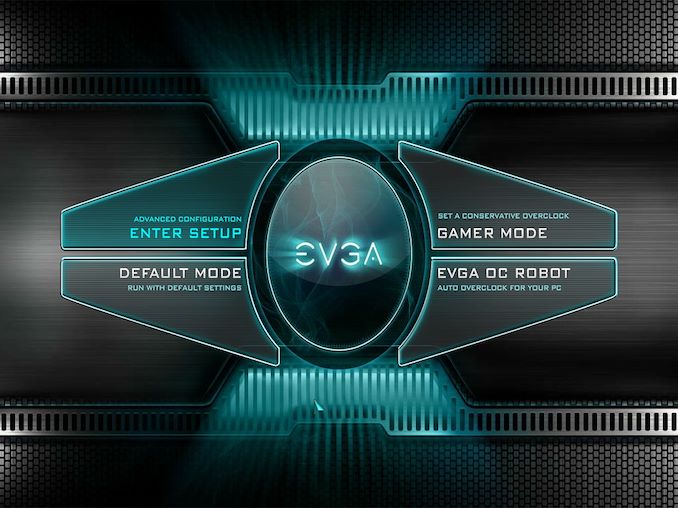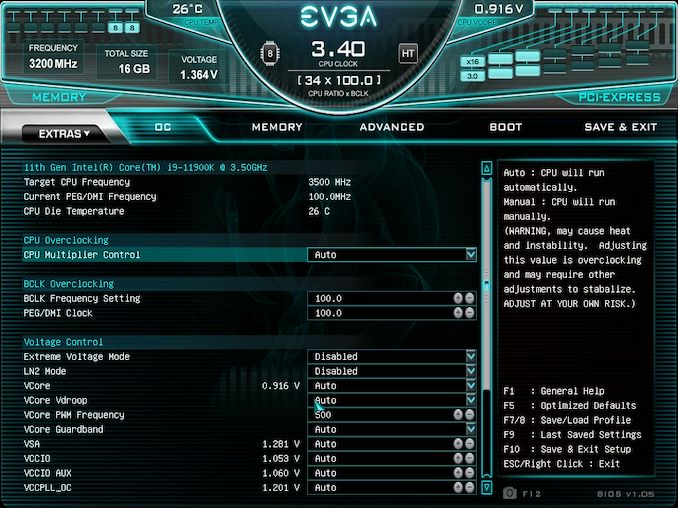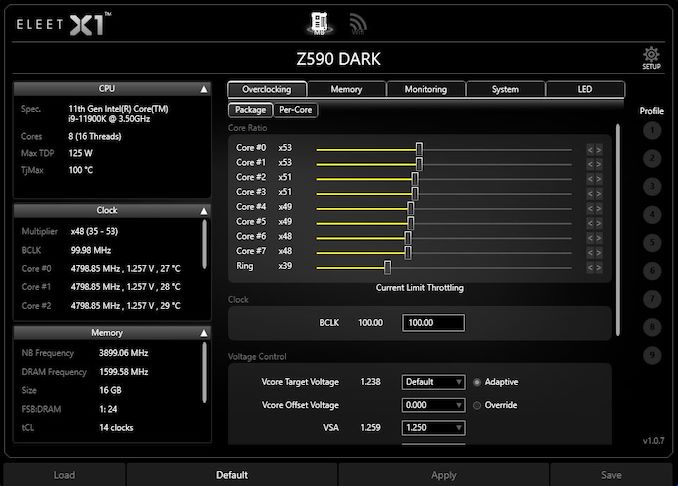The EVGA Z590 Dark Motherboard Review: For Extreme Enthusiasts
by Gavin Bonshor on October 15, 2021 9:00 AM ESTBIOS
The EVGA Z590 Dark firmware is consistent with other boards in its line-up, such as the X570 Dark, which we previously reviewed. The GUI. features a black and teal blue color theme throughout, with teal highlighting on the selected option and white text throughout.
The initial splash screen has four main options for users to select from. This includes entering the setup options for more advanced configuration of the settings and a default mode which will set all of the board's options to default settings. EVGA also includes a Gamer Mode that lets the firmware overclock the processor to a conservative level, which we will explore in the O.C. section of the review. The EVGA OC Robot pushes it to what the board thinks are the stable limits of the processor.
Entering the Enter Setup option from the splash screen takes users into the board's configurable settings. This includes an O.C. section where users can overclock the processor and integrated graphics on supported chips. For users looking to overclock the memory, EVGA consists of a dedicated area that includes memory overclocking presets provided by world-class overclockers KINGPIN and Luumi.
Other options include the advanced section with access to the board's chipset-related options and allowing users to enable or disable integrated controllers for networking and audio. Within the Boot section, users can boot to a specific installed drive and set the boot priority. In contrast, the Save and Exit section allows users to save the desired settings and boot into the operating system.
There's also a section within the advanced menu to access the H/W monitor settings, allowing users to customize fan profiles on each board's eight 4-pin fan headers. Overall the EVGA Z590 Dark firmware is consistent throughout; it's responsive. It has everything needed for extreme overclockers and enthusiasts to push Intel's Rocket Lake processors to its capabilities; this depends entirely on the level of cooling installed.
Software
Most of the following software analysis comes from our EVGA X570 Dark review due to the identical software packages supplied.
Much to EVGA's credit, it includes its software and driver installation files on a small USB stick instead of providing an optical disc. As we said in our EVGA X570 Dark review, we applaud this and wish other vendors would follow suit as optical media such as C.D.s and DVDs are often not supported on newer systems.
After plugging in the USB drive and opening the executable file, users can install all of the motherboard's core drivers, including the chipset, Intel Management Engine, and the integrated controllers. Users can also install the EVGA Eleet X1 and N.U. audio software, as well as Intel's UHD integrated graphics drivers, and use one of the inclusive EVGA wallpapers provided.
Looking at the EVGA ELEET X1 software, the utility amalgamates various elements, including overclocking, system monitoring, and control of both the integrated RGB LEDs and external ones users choose to install. There's plenty of overclocking options for users to customize for overclocking the CPU and memory on the fly within Windows. Options include CPU frequency (all-core only), CPU VCore, DRAM voltage, SoC, VDDP, P.L.L., and these can be adjusted without rebooting the system. This includes memory latencies that are handy for extreme overclockers looking to fine-tune settings without POSTing into Windows at unstable settings.
Overall, EVGA provides a functional and helpful set of software without delivering too much fluff. Users can change audio settings via the EVGA NU audio function or use Realtek's Audio Console for basic tuning. The EVGA Z590 Dark is geared for overclocking, the software does the job required, and we couldn't ask for any more than that.


























27 Comments
View All Comments
Wrs - Monday, October 18, 2021 - link
AM4 isn't that bad. AMD has a ways to catch up to Intel in architecture & support, but the Zen 3 core is great, the CCD process node is world class, and PBO is effortlessly stable. As of April 2021 the USB issues are no longer. I specifically waited till then to buy a 5800x. That's 8C, 1 CCD, comparable to RKL but at half the power. You really don't need to upgrade BIOS/AGESA unless there are issues, or you're changing the CPU/OS. Haven't heard of AM4 specific PCIe issues (shoddy riser cables are a physical thing), and WHEA errors come from unstable all-core OCs or not taking a few hours to test and tune XMP RAM, seeing as XMP is tested on Intel platforms.That said, AM4 is nearing EOL as well, just 7 or 9 months later than Z590. I view performance as effectively a toss-up between the two, but that is a painful power delta over several years of ownership.
Silver5urfer - Monday, October 18, 2021 - link
Sorry you are wrong. I've seen people reporting USB issues on OCN, Reddit, NBR and other forums. All the issues are an inherent design flaw of Ryzen. This is AMD's specific first time come back so It's kinda expected. Nobody should push their IMC part 3600MHz of 1:1 FCLK.You are parroting April because that's the AGESA 1.2.0.2 fix which did not fix anything. I read already 70 pages of the thread on OCN about initial batch issues and the new thread as well regarding WHEA, as I said. Run Zen 3 on barebone stock or don't bother if you bother the CPU will glitch out with all the issues. Period. I'm a new buyer man what should I have even an incentive for looking for all these ? because I don't want to dabble in headaches on a DIY build.
Wrs - Tuesday, October 19, 2021 - link
Idk how else to tell ya this. I actually run a 5800x, it sits on a B550 board, there's 64 GB of RAM (4 sticks) at 3600 MHz, and Fclk is 1800 MHz aka 1:1 as listed on CPU-z. I do not get USB dropouts for my mouse, keyboard, external drive, or occasional printer or thumb drive. I don't get WHEA errors when I leave HWInfo running for a few days. My average uptime (wall clock time between reboots) is 8 days 14 hours. I haven't had a bluescreen since I gave up per-core undervolting.We're in agreement that people reported USB issues. That's why I waited before buying the 5800x. I do not know if it was a design flaw or configuration error or even if my specific system needed fixing, but with AGESA 1.2.0.1 Patch A back in April (my mobo maker listed USB connectivity among the release notes) I've never had the chance to experience USB dropouts.
danny11 - Monday, October 18, 2021 - link
Unfortunately TiN is retired from EVGA. He moved to US I guess due to family. Now those nice amazing articles on Xdevs are nowhere since Z490 series. <a href="www.abcd.com">abc</a>KennethHo - Saturday, February 19, 2022 - link
Is this not a weird MB?It's a massive E-ATX board, but only has 2 usable PCIe slots and 2 DIMM slots, for $600, with OK performance.
https://jaredspears.com/
ridnout - Monday, August 1, 2022 - link
That is to accommodate NVLink with 4-slot spacing because of the size of premium 30 Series Nvidia and 6000 series AMD offerings. Blower style fans are limited as per Nvidia, so adequate spacing for cards using NVLink (think SLI on steroids) is a must for cooling the hotter 3080/90 graphics cards. For machine learning, scientific computing, CAD, video editing, and host of other professional applications that can leverage NVLink, a linked pair of 3090 will markedly outperform on most tasks a an A6000 for a fraction of the cost. Remember, the consumer cards won't do high precision...limitations of the drivers.Just 2 cents.
haileynelson10 - Wednesday, April 13, 2022 - link
Appreciate detailed reviews for EVGA Z590 Dark Motherboard. I still have some doubts but this post solves it.https://findaword.co/